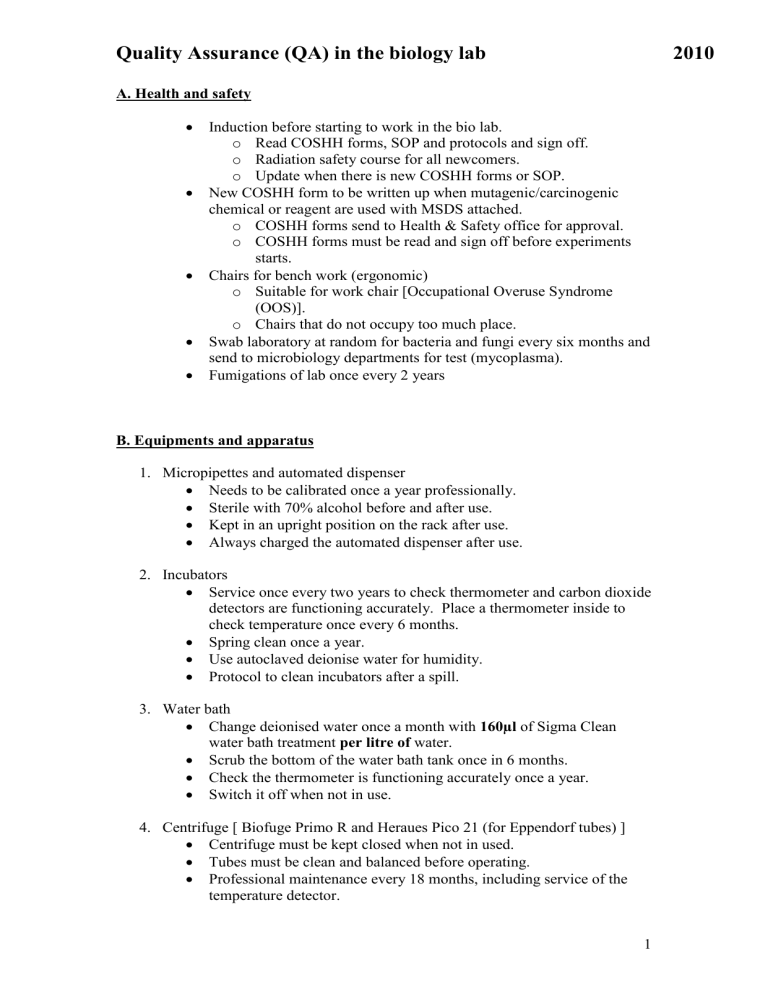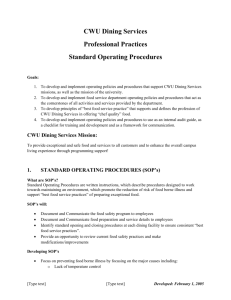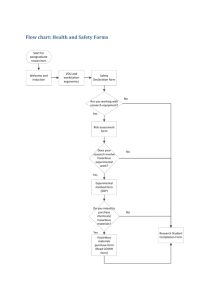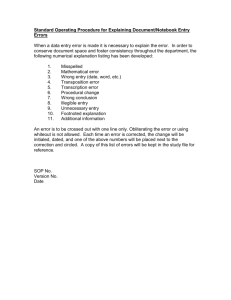here. - SPIRIT

Quality Assurance (QA) in the biology lab
A. Health and safety
Induction before starting to work in the bio lab. o Read COSHH forms, SOP and protocols and sign off. o Radiation safety course for all newcomers. o Update when there is new COSHH forms or SOP.
New COSHH form to be written up when mutagenic/carcinogenic chemical or reagent are used with MSDS attached. o COSHH forms send to Health & Safety office for approval. o COSHH forms must be read and sign off before experiments starts.
Chairs for bench work (ergonomic) o Suitable for work chair [Occupational Overuse Syndrome
(OOS)]. o Chairs that do not occupy too much place.
Swab laboratory at random for bacteria and fungi every six months and send to microbiology departments for test (mycoplasma).
Fumigations of lab once every 2 years
B. Equipments and apparatus
1.
Micropipettes and automated dispenser
Needs to be calibrated once a year professionally.
Sterile with 70% alcohol before and after use.
Kept in an upright position on the rack after use.
Always charged the automated dispenser after use.
2.
Incubators
Service once every two years to check thermometer and carbon dioxide detectors are functioning accurately. Place a thermometer inside to check temperature once every 6 months.
Spring clean once a year.
Use autoclaved deionise water for humidity.
Protocol to clean incubators after a spill.
3.
Water bath
Change deionised water once a month with
160µl
of Sigma Clean water bath treatment per litre of water.
Scrub the bottom of the water bath tank once in 6 months.
Check the thermometer is functioning accurately once a year.
Switch it off when not in use.
4.
Centrifuge [ Biofuge Primo R and Heraues Pico 21 (for Eppendorf tubes) ]
Centrifuge must be kept closed when not in used.
Tubes must be clean and balanced before operating.
Professional maintenance every 18 months, including service of the temperature detector.
2010
1
Quality Assurance (QA) in the biology lab
Clean after each use and switch it off.
SOP available for cleaning after spillage in the centrifuge.
5.
Laminar air flow (LAF)
Sterile with 70% alcohol before and after use.
Waste bottles in the LAF must be filled with approximate 40 ml Bio
Cleanse before use. Keep waste bottle closed tight after use.
Fumigate once every 2 years.
Professional service and change filter when required, including testing the airflow.
6.
Fridge and freezer
Do not open the freezer too long as it will increase ice formation.
Scrap off ice when needed and keep it neat and tidy.
Labelled everything kept in the fridge/freezer with name, date and year.
Only clean bottles are allowed in the fridge/freezer.
Check every 3 months and discard expired items.
Any spill, clean according to SOP.
7.
Liquid nitrogen Dewar.
Check for temperature accuracy.
Check for microplasmas once a year.
Do not place vial on the top level of the holder.
Always check nitrogen level (top up) to ensure optimum temperature.
Top up nitrogen weekly on Friday.
8.
Microscopes
Clean after use and turn off.
Never use alcohol to wipe the stage as this will unglued the joints.
Lens paper to be used when cleaning lens and not tissue paper.
Need to be professionally serviced every 18 months, including lens clean, and service of the stage and the technical parts.
9.
Autoclave
Train new user before usage.
Clean the autoclave according to SOP.
Everything that is to be autoclaved must be pasted with autoclave tapes.
Always check for water level before use.
10.
Neubauer chambers
Clean immediately after use (SOP).
Place in a Petri dish with cover to avoid dust.
11.
Cells shaker
Operate according to supplier instructions.
Need to be placed on a stable place.
2010
2
Quality Assurance (QA) in the biology lab
12.
Sonicator
Use according to supplier instructions.
Wash and keep dry when not in use.
13.
Coulter counter
Calibrate once a year with beads.
When using a different size cells, needs to calibrate the aperture.
Read SOP.
14.
Vortex
Use on a stable place.
Clean after use.
15.
End-stage of vertical beam
Keep the aperture and stage clean to prevent contamination of cells.
Always keep the door closed when beam is running.
Ensure two persons are present when working with beam.
Keep the stage area tidy and clean at all time.
16.
Chemical cabinet in the lab.
Labelled every chemical bottle.
Discard expired chemical and reagents.
Arrange the chemicals in alphabetical order.
17.
Tubing for extraction of waste from dishes/plates
Tubing must be kept clean; hang it up and don’t leave it lying on the floor on in the yellow bin.
Make sure the tubing is clear of crystal violet stain and sterile with
70% alcohol and wipe dry after use.
Avoid dripping crystal violet stain on the floor and clean immediately when spilled.
C. Reagents and chemicals
Store in a well conditioned cupboard.
Indicate the date of opening and name on the bottles.
Check for expiry dates, using the earliest first.
Always be on the look out for contaminations before use of media.
For commonly used reagent, use the opened bottle first.
Sterile with 70% alcohol and wipe dry before and after use.
2010
3
Quality Assurance (QA) in the biology lab
D. Supplies and perishables
Store plastic supplies in the metal cupboard outside the lab.
Autoclaved before use: o Micropipettes tips o Deionised water for incubator o Mylar dishes
Absolute ethanol kept in the chemical cabinet. o Use as 70% alcohol from this as disinfectant.
Deionise water; o Make sure it is microorganism free, test once a year by collecting the water and test for mycoplasma.
Do stock check once a month.
When placing orders, go through the person in-charge (currently Ming
Chew) to avoid double orders.
Orders must be approved by the person-in-charge before going through to Karen Arthur.
E. Cell lines
Always work with one cell line at a time to avoid cross contamination.
For non commercial cell lines, mycoplasmas must be tested before the start of any experiments. (Required for reports to be published and working in other lab).
Advisable to test for mycoplasma once a year for all cell line.
Freeze down cells that are not in use according to SOP.
When thawing cell line, washed off DMSO before seeding. For media containing serum, add more serum to remove DMSO.
F. Ambience
Optimised temperature must be constant to maintain media kept in the cupboard. Check every month by monitoring the daily chart collected.
General cleaning procedures (for cleaners). o Mop the floor with disinfectant once a week. o Vacuum the floor once a week (underneath trolley, etc). o ‘Spring clean day’ once a year (also involves staff).
Roster for maintenance of the general ambience by co-workers will be devised by person-in-charge. o Deionised water and absolute ethanol from chemistry lab. o Yellow bins. o Sharp bins. o Water bath maintenance. o Liquid nitrogen tank (top up every week).
2010
4
Quality Assurance (QA) in the biology lab o Lab coats (send for washing in Chemistry dept). o It is everyone’s responsibility to see that their rostered action is completed, arranging their own cover where necessary.
G. Waste
Closed yellow bin lid after use.
Never place liquid in the yellow bins.
Fill and labelled waste bottles with approximately 40ml of Bio Cleanse and cap securely after use.
Full waste bottle caps must be tightly secured and discard in the yellow bin.
Yellow bin send to waste area in the estate and facility site.
Never pour carcinogenic/mutagenic/poisonous/flammable liquid into the sink. Discard in waste bottle for officially approved disposal.
Author: Ming Chew
Referee: Charlie Jeynes
Date: 15 March 2010
Date: 27 April 2010
2010
5



